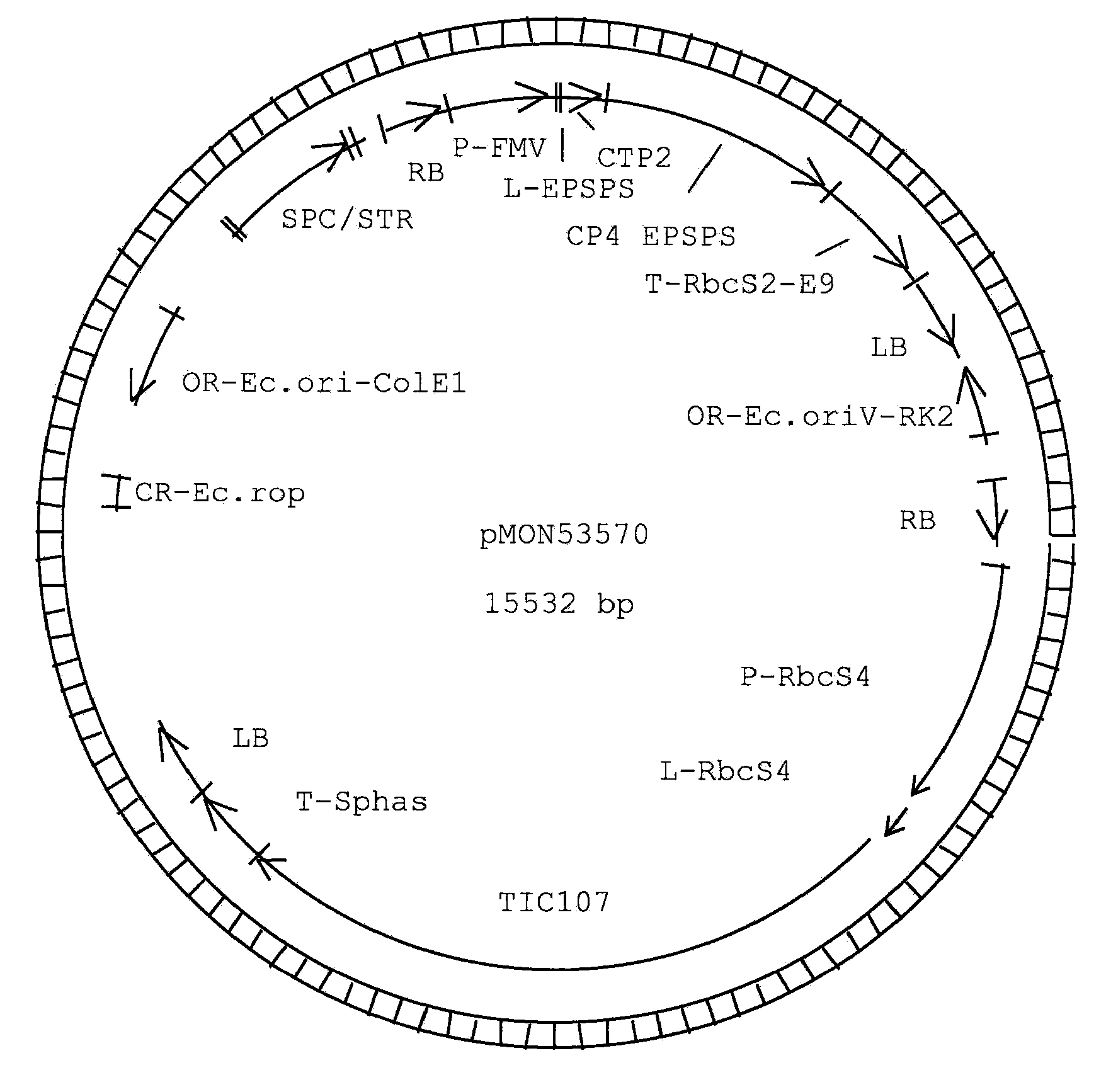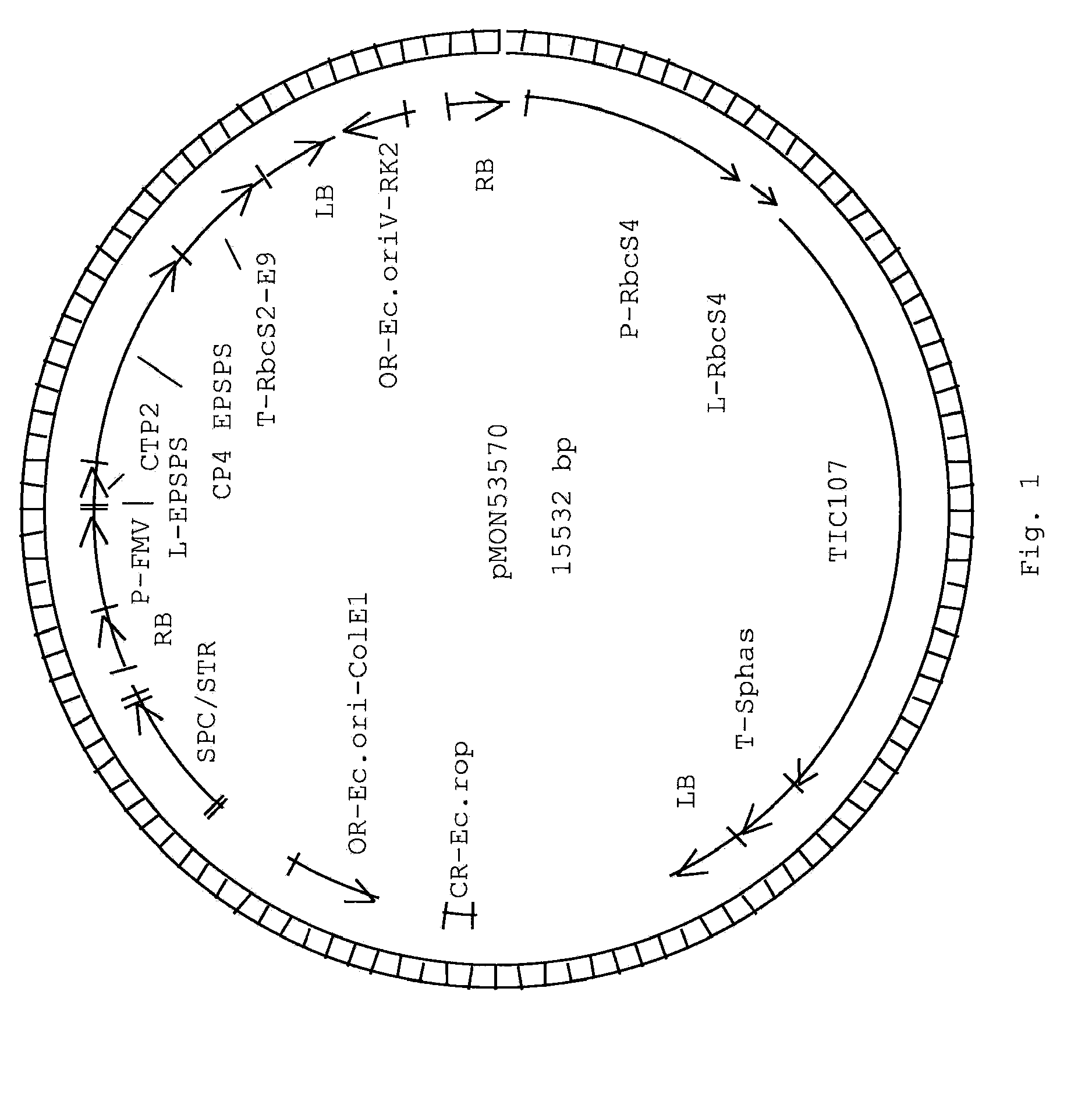Soybean Plant And Seed Corresponding To Transgenic Event MON87701 And Methods For Detection Thereof
- Summary
- Abstract
- Description
- Claims
- Application Information
AI Technical Summary
Benefits of technology
Problems solved by technology
Method used
Image
Examples
example 1
Transformation of Soybean A5547 with pMON53570 and Event Selection
[0092]The transgenic soybean plant MON87701 was generated by an Agrobacterium-mediated transformation of soybean cells with a DNA fragment derived from pMON53570 (FIG. 1). The binary plant transformation vector, pMON53570, contains two plant transformation cassettes or T-DNAs. Each cassette is flanked by right border and left border sequences at the 5′ and 3′ ends of the transformation cassette, respectively. An expression cassette, presented as SEQ ID NO:7, is used for the expression of an insect toxin. The expression cassette is comprised of a promoter and leader sequence derived from the Arabidopsis ribulose 1,5-bisphosphate carboxylase small subunit gene (P-RbcS4, Krebbers et al., (1988) Plant Mol. Biol. 11: 745-759) which is cloned directly upstream of the insect toxin coding sequence, TIC107, which in turn is cloned directly upstream of a terminator sequence derived from the Glycine max 7S alpha′ beta conglycini...
example 2
Isolation of Flanking Sequences Using Inverse PCR
[0097]Sequences flanking the T-DNA insertion in MON87701 were determined using inverse PCR as described in Ochman et al., 1990 (PCR Protocols: A guide to Methods and Applications, Academic Press, Inc.). Plant genomic DNA was isolated from both Asgrow A5547 and the transgenic lines from tissue grown under green house conditions for Southern and TAQMAN® analysis. Approximately 1 gram of young trifoliate leaf tissue was combined with liquid nitrogen and ground to a fine powder using a mortar and pestle. DNA was extracted using a Nucleon Plant DNA extraction kit (RPN8511, Amersham, Piscataway, N.J.) according to the manufacturer's protocol. After the final precipitation step, DNAs were resuspended in 0.5 ml of TE (10 mM Tris-HCl pH 8.0, 1 mM EDTA). This method can be modified by one skilled in the art to extract DNA from any tissue of soybean, including, but not limited to seed.
[0098]An aliquot of DNA was digested with restriction endonuc...
example 3
Event Specific Endpoint TAQMAN® and Zygosity Assays
[0100]The methods used to identify event MON87701 in a sample are described in an event specific endpoint TAQMAN® PCR for which examples of conditions are described in Table 1 and Table 2. The DNA primers used in the endpoint assay are primers SQ1135 (SEQ ID NO:9), SQ1136 (SEQ ID NO:10) and 6FAM™ labeled primer PB63 (SEQ ID NO:11). 6FAM™ is a fluorescent dye product of Applied Biosystems (Foster City, Calif.) attached to the DNA primer. For TAQMAN® MGB probes, the 5′ exonuclease activity of Taq DNA polymerase cleaves the probe from the 5′-end, between the fluorophore and quencher. When hybridized to the target DNA strand, quencher and fluorophore are separated enough to produce a fluorescent signal, thus releasing fluorescence.
[0101]SQ1135 (SEQ ID NO:9) and SQ1136 (SEQ ID NO:10) when used in these reaction methods with PB63 (SEQ ID NO:11) produce a DNA amplicon that is diagnostic for event MON87701 DNA. The controls for this analysi...
PUM
| Property | Measurement | Unit |
|---|---|---|
| Length | aaaaa | aaaaa |
Abstract
Description
Claims
Application Information
 Login to View More
Login to View More - R&D
- Intellectual Property
- Life Sciences
- Materials
- Tech Scout
- Unparalleled Data Quality
- Higher Quality Content
- 60% Fewer Hallucinations
Browse by: Latest US Patents, China's latest patents, Technical Efficacy Thesaurus, Application Domain, Technology Topic, Popular Technical Reports.
© 2025 PatSnap. All rights reserved.Legal|Privacy policy|Modern Slavery Act Transparency Statement|Sitemap|About US| Contact US: help@patsnap.com



